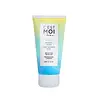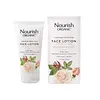What's inside
What's inside
 Key Ingredients
Key Ingredients

 Benefits
Benefits

 Concerns
Concerns

 Ingredients Side-by-side
Ingredients Side-by-side

Water
Skin ConditioningGlycerin
HumectantPrunus Amygdalus Dulcis Oil
Skin ConditioningCetearyl Alcohol
EmollientButyrospermum Parkii Butter
Skin ConditioningLeuconostoc/Radish Root Ferment Filtrate
AntimicrobialPropanediol
SolventCera Alba
EmollientRosa Centifolia Flower Water
Skin ConditioningCetearyl Glucoside
EmulsifyingCetyl Palmitate
EmollientAloe Barbadensis Leaf Juice
Skin ConditioningXanthan Gum
EmulsifyingSodium Phytate
Helianthus Annuus Seed Oil
EmollientOryza Sativa Extract
AbsorbentTocopherol
AntioxidantActinidia Chinensis Fruit Extract
EmollientOctyldodecyl Myristate
EmollientFragaria Vesca Fruit Extract
AstringentCalendula Officinalis Flower Extract
MaskingZea Mays Starch
AbsorbentPyrus Malus Fruit Extract
Skin ConditioningSodium Benzoate
MaskingPotassium Sorbate
PreservativeCitric Acid
BufferingSodium Levulinate
Skin ConditioningWater, Glycerin, Prunus Amygdalus Dulcis Oil, Cetearyl Alcohol, Butyrospermum Parkii Butter, Leuconostoc/Radish Root Ferment Filtrate, Propanediol, Cera Alba, Rosa Centifolia Flower Water, Cetearyl Glucoside, Cetyl Palmitate, Aloe Barbadensis Leaf Juice, Xanthan Gum, Sodium Phytate, Helianthus Annuus Seed Oil, Oryza Sativa Extract, Tocopherol, Actinidia Chinensis Fruit Extract, Octyldodecyl Myristate, Fragaria Vesca Fruit Extract, Calendula Officinalis Flower Extract, Zea Mays Starch, Pyrus Malus Fruit Extract, Sodium Benzoate, Potassium Sorbate, Citric Acid, Sodium Levulinate
Aloe Barbadensis Leaf Juice
Skin ConditioningButyrospermum Parkii Butter
Skin ConditioningAlcohol Denat. Sd Alcohol 38-D
SolventHydrolyzed Yeast
Skin ConditioningArgania Spinosa Kernel Oil
EmollientTheobroma Grandiflorum Seed Butter
Skin ConditioningLecithin
EmollientRosa Damascena Flower
Skin ConditioningEuterpe Oleracea Fruit Oil
Skin ConditioningPrunus Amygdalus Dulcis Oil
Skin ConditioningOryza Sativa Bran Extract
Skin ConditioningTocopherol
AntioxidantAscorbic Acid
AntioxidantCitrus Aurantium Dulcis Peel Oil
MaskingGlycerin
HumectantXanthan Gum
EmulsifyingAloe Barbadensis Leaf Juice, Butyrospermum Parkii Butter, Alcohol Denat. Sd Alcohol 38-D, Hydrolyzed Yeast, Argania Spinosa Kernel Oil, Theobroma Grandiflorum Seed Butter, Lecithin, Rosa Damascena Flower, Euterpe Oleracea Fruit Oil, Prunus Amygdalus Dulcis Oil, Oryza Sativa Bran Extract, Tocopherol, Ascorbic Acid, Citrus Aurantium Dulcis Peel Oil, Glycerin, Xanthan Gum
Ingredients Explained
These ingredients are found in both products.
Ingredients higher up in an ingredient list are typically present in a larger amount.
Aloe Barbadensis Leaf Juice comes from leaves of the aloe plant. Aloe Barbadensis Leaf Juice is best known for helping to soothe sunburns. It is also anti-inflammatory, moisturizing, antiseptic, and can help heal wounds.
Aloe is packed with good stuff including Vitamins A, C, and E. These vitamins are antioxidants, which help fight free-radicals and the damage they may cause. Free-radicals are molecules that may damage your skin cells, such as pollution.
Aloe Barbadensis Leaf Juice also contains sugars. These sugars come in the form of monosaccharides and polysaccharides, folic acid, and choline. These sugars are able to help bind moisture to skin.
It also contains minerals such as calcium, 12 anthraquinones, fatty acids, amino acids, and Vitamin B12.
Learn more about Aloe Barbadensis Leaf JuiceThis ingredient is also known as shea butter. It is an effective skin hydrator and emollient.
Emollients help soothe and soften your skin. It does this by creating a protective film on your skin. This barrier helps trap moisture and keeps your skin hydrated. Emollients may be effective at treating dry or itchy skin.
Shea butter is rich in antioxidants. Antioxidants help fight free-radicals, or molecules that may harm the body. It is also full of fatty acids including stearic acid and linoleic acid. These acids help replenish the skin and keep skin moisturized.
While Shea Butter has an SPF rating of about 3-4, it is not a sunscreen replacement.
Shea butter may not be fungal acne safe. We recommend speaking with a professional if you have any concerns.
Learn more about Butyrospermum Parkii ButterGlycerin is already naturally found in your skin. It helps moisturize and protect your skin.
A study from 2016 found glycerin to be more effective as a humectant than AHAs and hyaluronic acid.
As a humectant, it helps the skin stay hydrated by pulling moisture to your skin. The low molecular weight of glycerin allows it to pull moisture into the deeper layers of your skin.
Hydrated skin improves your skin barrier; Your skin barrier helps protect against irritants and bacteria.
Glycerin has also been found to have antimicrobial and antiviral properties. Due to these properties, glycerin is often used in wound and burn treatments.
In cosmetics, glycerin is usually derived from plants such as soybean or palm. However, it can also be sourced from animals, such as tallow or animal fat.
This ingredient is organic, colorless, odorless, and non-toxic.
Glycerin is the name for this ingredient in American English. British English uses Glycerol/Glycerine.
Learn more about GlycerinPrunus Amygdalus Dulcis Oil comes from the sweet almond, a tree native to Iran. This oil has no fragrance and is non-volatile.
Almonds contain healthy fats, vitamins, and minerals. It is a rich source of Vitamin E, a great antioxidant and skin conditioning ingredient. Sweet almond oil contains fatty acids such as linolenic acid and triglycerides.
The content of sweet almond oil makes it a great emollient; it can help soften and hydrate your skin. Emollients create a barrier over your skin to trap moisture in. Sweet almond oil has antioxidant properties.
Those with an almond allergy should be careful of this ingredient and speak with a professional about using it in your skincare.
This ingredient may not be fungal-acne safe.
Learn more about Prunus Amygdalus Dulcis OilTocopherol (also known as Vitamin E) is a common antioxidant used to help protect the skin from free-radicals and strengthen the skin barrier. It's also fat soluble - this means our skin is great at absorbing it.
Vitamin E also helps keep your natural skin lipids healthy. Your lipid skin barrier naturally consists of lipids, ceramides, and fatty acids. Vitamin E offers extra protection for your skin’s lipid barrier, keeping your skin healthy and nourished.
Another benefit is a bit of UV protection. Vitamin E helps reduce the damage caused by UVB rays. (It should not replace your sunscreen). Combining it with Vitamin C can decrease sunburned cells and hyperpigmentation after UV exposure.
You might have noticed Vitamin E + C often paired together. This is because it is great at stabilizing Vitamin C. Using the two together helps increase the effectiveness of both ingredients.
There are often claims that Vitamin E can reduce/prevent scarring, but these claims haven't been confirmed by scientific research.
Learn more about TocopherolXanthan gum is used as a stabilizer and thickener within cosmetic products. It helps give products a sticky, thick feeling - preventing them from being too runny.
On the technical side of things, xanthan gum is a polysaccharide - a combination consisting of multiple sugar molecules bonded together.
Xanthan gum is a pretty common and great ingredient. It is a natural, non-toxic, non-irritating ingredient that is also commonly used in food products.
Learn more about Xanthan Gum